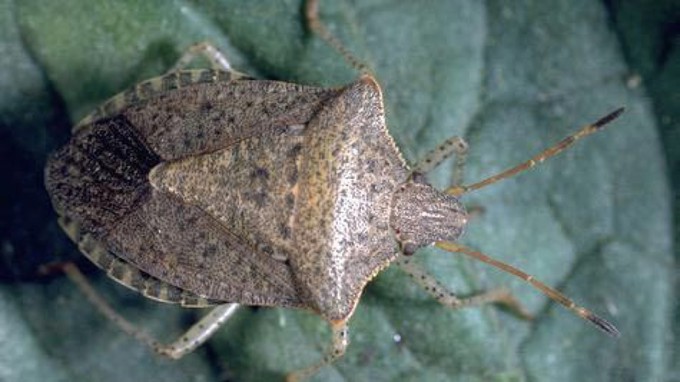
Stink bugs and leaf-footed bugs like August weather and ripening fruit

Consperse stink bugs are the most common stink bugs in the Sacramento area. Courtesy UCIPM, photo by Jack Kelly Clark
When tomatoes hit their peak in summer, so do bugs that like to feed on them.
Right now, Sacramento gardeners are seeing a bunch of real stinkers – stink bugs and their close cousins, leaffooted bugs. Gardeners see them scrambling over ripening tomatoes, especially in late afternoon or early evening. They like to dine on other juicy fruit, too, such as peaches, pears and pomegranates.
Both stink bugs and leaffooted bugs inject their long “tongues” into fruit and suck out as much juice as possible. In the process, they leave behind yucky-tasting residue and telltale pinpricks on the fruit’s skin.
Stink bugs are shaped like little gray or brown shields. Mature adults can fly but younger stinkers tend to just hop, which makes them easier to catch.
Brown marmorated stink bugs (BMSB) have gotten a lot of recent publicity because of their potential threat; they like to eat almost everything and have few if any natural predators in California. Spotted in several Sacramento area neighborhoods, this invasive insect from Asia is voracious and attacks vegetables and ornamental plants as well as fruit.
BMSB likes to lay its eggs (that look like little pearls) on the back of sunflower leaves. That makes sunflowers a good sentinel plant; check sunflower leaves regularly and when eggs are spotted, pick and destroy the leaf. That can prevent the appearance of more BMSB.
Much more common in Sacramento is the consperse stink bug. This stink bug looks a lot like BMSB. Its most visible difference is its antennae; BMSB have white stripes, consperse do not.
Parasitic wasps usually keep consperse stink bug populations from exploding out of control. Consperse stink bugs are relatively slow moving and easily caught; they hop down when disturbed.
Pesticides are not very effective on stink bugs, and not necessary. Instead, spray tomatoes with insecticidal soap (1 tablespoon mild dish detergent or liquid soap to 1 quart water) if stink bugs are seen.
Or use the bucket method: Place under the tomato plant a bucket or dishpan half filled with water and a teaspoon of dish detergent (the soap breaks the water’s surface tension). Give the plant a gentle shake; stink bugs will fall into the water and drown. (They can’t swim.)
For more on stink bugs and control: https://ipm.ucanr.edu/PMG/GARDEN/VEGES/PESTS/stinkbug.html
Also appearing now are two species of leaffooted bugs. This insect gets its nickname from the leaf-like extensions on its back legs. The nymphs generally stick together for protection. The adults can fly and are much more mobile.
Common in Sacramento are inch-tall leaffooted bugs that have little zigzag stripes. That’s Leptoglossus zonatus. Smaller and darker are another leaffooted species: Leptoglossus occidentalis.
Populations of both species tend to swell in midsummer.
“Overwintering leaffooted bugs can lay over 200 eggs during a two-month period in the spring,” say the UC Cooperative Extension pest notes. “Nymphs emerge from the eggs about 1 week after being deposited, after which they develop into adults in 5 to 8 weeks. Adults are long-lived and can lay eggs over an extended period, so the population can consist of all life stages by late June. At this time, overwintering adults are still alive as the first generation of their offspring develop into adults.”
Throughout the summer, two to three generations of leaffooted bugs may be coexisting in the garden at the same time. All of them will attack tomatoes.
The bucket method works on leaffooted bugs, too. They tend to scramble away from people, so slip the container under the tomatoes, then make motions from above or gently shake the vine’s trellis. The bugs will hop off the fruit – and right into the water.
For more on identifying and combating leaffooted bugs: http://ipm.ucanr.edu/PMG/PESTNOTES/pn74168.html
Comments
0 comments have been posted.Sacramento Digs Gardening to your inbox.
Sites We Like
Garden Checklist for week of Oct. 27
It's still great weather for gardening. Grab a sweater – and an umbrella, just in case – then get to work:
* October is the best month to plant trees, shrubs and perennials.
* Harvest pumpkins and winter squash.
* Pick apples and persimmons. Remember to pick up fallen fruit, too; it attracts pests.
* Clean up the summer vegetable garden and compost disease-free foliage.
* Dig up corms and tubers of gladioli, dahlias and tuberous begonias after the foliage dies. Clean and store in a cool, dry place.
* Treat azaleas, gardenias and camellias with chelated iron if leaves are yellowing between the veins.
* Now is the time to plant seeds for many flowers directly into the garden, including cornflower, nasturtium, nigella, poppy, portulaca, sweet pea and stock.
* Plant seeds for radishes, bok choy, mustard, spinach and peas.
* Plant garlic and onions.
* Set out cool-weather bedding plants, including calendula, pansy, snapdragon, primrose and viola.
* Reseed and feed the lawn. Work on bare spots.